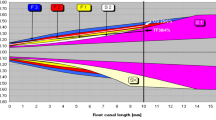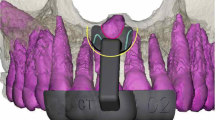Abstract
Objectives
This prospective study introduced a digitally designed sectioning guide and evaluated its feasibility for the extraction of horizontally impacted lower third molars.
Materials and methods
This study included 38 horizontally impacted lower third molars, randomly divided into experimental and control groups. The teeth were extracted using a 3D-printed titanium surgical guide in the experimental group; free-hand extractions were performed in the control group. The surgical duration, tooth sectioning duration, cortical bone perforation, and postoperative complications, including pain, swelling, trismus, dry socket, infection, and hemorrhage, were evaluated.
Results
Although not statistically significant, guided surgery tended to reduce the number of tooth sectioning steps compared to free-hand extractions. There were no cases of cortical bone perforation in the experimental group. Although the surgical duration was greater in the experimental group (p < 0.05), there were no differences in postoperative pain, swelling, and trismus. There were no cases of postoperative infection and hemorrhage in either group.
Conclusions
3D-printed titanium surgical guides had superior accuracy and safety compared to free-hand surgery. Further studies with larger sample sizes are required to verify these findings.
Clinical relevance
The template improved the safety of tooth sectioning during impacted lower third molar surgery and resulted in a more predictable extraction. The narrow sectioning groove could fit comfortably with hypertrophic soft tissues in the posterior mandible.



Similar content being viewed by others
References
Cicciù M, Stacchi C, Fiorillo L, Cervino G, Troiano G, Vercellotti T, Herford AS, Galindo-Moreno P, Di Lenarda R (2021) Piezoelectric bone surgery for impacted lower third molar extraction compared with conventional rotary instruments: a systematic review, meta-analysis, and trial sequential analysis. Int J Oral Maxillofac Surg 50(1):121–131. https://doi.org/10.1016/j.ijom.2020.03.008
Magesty RA, Galvão EL, de Castro MC, Dos Santos CRR, Falci SGM (2017) Rotary instrument or piezoelectric for the removal of third molars: a meta-analysis. J Maxillofac Oral Surg 16(1):13–21. https://doi.org/10.1007/s12663-016-0938-y
El Kholy K, Lazarin R, Janner SFM, Faerber K, Buser R, Buser D (2019) Influence of surgical guide support and implant site location on accuracy of static Computer-Assisted Implant Surgery. Clin Oral Implants Res 30(11):1067–1075. https://doi.org/10.1111/clr.13520
Gao J, Li J, Liu C, Fan L, Yu J, Yu H (2020) A stereolithographic template for computer-assisted teeth preparation in dental esthetic ceramic veneer treatment. J Esthet Restor Dent 32(8):763–769. https://doi.org/10.1111/jerd.12644
Connert T, Zehnder MS, Weiger R, Kühl S, Krastl G (2017) Microguided endodontics: accuracy of a miniaturized technique for apically extended access cavity preparation in anterior teeth. J Endod 43(5):787–790. https://doi.org/10.1016/j.joen
Moreno-Rabié C, Torres A, Lambrechts P, Jacobs R (2020) Clinical applications, accuracy and limitations of guided endodontics: a systematic review. Int Endod J 53(2):214–231. https://doi.org/10.1111/iej.13216
Xingzhou Q, Wang Z, Ong HS, Chenping Z, Abdelrehem A (2020) Accuracy of computer-aided design/computer-aided manufacturing surgical template for guidance of dental implant distraction in mandibular reconstruction with free fibula flaps. J Craniofac Surg 31(2):355–359. https://doi.org/10.1097/SCS.0000000000006112
Verweij JP, Jongkees FA, Anssari Moin D, Wismeijer D, van Merkesteyn JPR (2017) Autotransplantation of teeth using computer-aided rapid prototyping of a three-dimensional replica of the donor tooth: a systematic literature review. Int J Oral Maxillofac Surg 46(11):1466–1474. https://doi.org/10.1016/j.ijom.2017.04.008
Smitkarn P, Subbalekha K, Mattheos N, Pimkhaokham A (2019) The accuracy of single-tooth implants placed using fully digital-guided surgery and freehand implant surgery. J Clin Periodontol 46(9):949–957. https://doi.org/10.1111/jcpe.13160
Tahmaseb A, Wu V, Wismeijer D, Coucke W, Evans C (2018) The accuracy of static computer-aided implant surgery: a systematic review and meta-analysis. Clin Oral Implants Res 29(Suppl 16):416–435. https://doi.org/10.1111/clr.13346
Schelbert T, Gander T, Blumer M, Jung R, Rücker M, Rostetter C (2019) Accuracy of computer-guided template-based implant surgery: a computed tomography-based clinical follow-up study. Implant Dent 28(6):556–563. https://doi.org/10.1097/ID.0000000000000936
Park JY, Song YW, Park SH, Kim JH, Park JM, Lee JS (2020) Clinical factors influencing implant positioning by guided surgery using a nonmetal sleeve template in the partially edentulous ridge: multiple regression analysis of a prospective cohort. Clin Oral Implants Res 31(12):1187–1198. https://doi.org/10.1111/clr.13664
Ahmed M, Salah MK, Khairy N (2018) Computer-aided design/computer-aided manufacturing cutting guides for odontectomy of deeply impacted mandibular third molars. Maced J Med Sci 6(12):2395–2401. https://doi.org/10.3889/oamjms.2018.371
Wang J, Cui NH, Guo YJ, Zhang W (2017) Navigation-guided extraction of impacted supernumerary teeth: a case report. J Oral Maxillofac Surg 75(6):1136.e1-1136.e5. https://doi.org/10.1016/j.joms.2017.02.001
Qi W, Lei J, Liu YN, Li JN, Pan J, Yu GY (2019) Evaluating the risk of post-extraction inferior alveolar nerve injury through the relative position of the lower third molar root and inferior alveolar canal. Int J Oral Maxillofac Surg 48(12):1577–1583. https://doi.org/10.1016/j.ijom.2019.07.008
Sandhu A, Sandhu S, Kaur T (2010) Comparison of two different flap designs in the surgical removal of bilateral impacted mandibular third molars. Int J Oral Maxillofac Surg 39(11):1091–1096. https://doi.org/10.1016/j.ijom.2010.07.003
Szalma J, Lovász BV, Lempel E, Maróti P (2019) Three-dimensionally printed individual drill sleeve for depth-controlled sections in third molar surgery. J Oral Maxillofac Surg 77(4):704.e1-704.e7. https://doi.org/10.1016/j.joms.2018.11.028
Jain N, Thomas S, Prabhu S, Jain S, Pathak AD, Pillai A, Satpathy M (2016) Influence of tooth sectioning technique and various risk factors in reducing the IAN injury following surgical removal of an impacted mandibular third molar. Oral Maxillofac Surg 20(2):149–156. https://doi.org/10.1007/s10006-015-0540-3
Mavrodi A, Ohanyan A, Kechagias N, Tsekos A, Vahtsevanos K (2015) Influence of two different surgical techniques on the difficulty of impacted lower third molar extraction and their post-operative complications. Med Oral Patol Oral Cir Bucal 20(5):e640–e644. https://doi.org/10.4317/medoral.20605
Yadav S, Verma A, Sachdeva A (2014) Assessment of lingual nerve injury using different surgical variables for mandibular third molar surgery: a clinical study. Int J Oral Maxillofac Surg 43(7):889–893. https://doi.org/10.1016/j.ijom.2014.01.013
Scolozzi P (2022) Buccal corticotomy using piezosurgery as a surgical approach for removal of deeply impacted mandibular teeth: an alternative procedure to avoid pitfalls associated with the conventional technique. J Stomatol Oral Maxillofac Surg 123(2):142–146. https://doi.org/10.1016/j.jormas.2021.04.012
Laino L, Mariani P, Laino G, Cervino G, Cicciù M (2021) Impacted lower third molar under inferior alveolar canal: technical strategy for minimally invasive extraoral surgical approach. J Craniofac Surg 32(5):1890–1893. https://doi.org/10.1097/SCS.0000000000007457
Gulnahar Y, Alpan AL (2021) Comparison of postoperative morbidity between piezoelectric surgery and conventional rotary instruments in mandibular third molar surgery: a split-mouth clinical study. Med Oral Patol Oral Cir Bucal 26(3):e269–e275. https://doi.org/10.4317/medoral.24085
Silva LD, Reis EN, Bonardi JP, Lima VN, Aranega AM, Ponzoni D (2020) Influence of surgical ultrasound used in the detachment of flaps, osteotomy and odontosection in lower third molar surgeries. A prospective, randomized, and “split-mouth” clinical study. Med Oral Patol Oral Cir Bucal. 25(4):e461–e467. https://doi.org/10.4317/medoral.23447
de Freitas Silva L, de Carvalho Ribeiro, Reis EN, Oliveira Souza BC, Egas LS, Aranega AM, Ponzoni D (2019) Alveolar repair after the use of piezosurgery in the removal of lower third molars: a prospective clinical, randomised, double-blind, split-mouth study. Br J Oral Maxillofac Surg 57(10):1068–1073. https://doi.org/10.1016/j.bjoms.2019.09.017
Troiano G, Laino L, Cicciù M, Cervino G, Fiorillo L, D’amico C, Zhurakivska K, Lo Muzio L (2018) Comparison of two routes of administration of dexamethasone to reduce the postoperative sequelae after third molar surgery: a systematic review and meta-analysis. Open Dent J 12:181–188. https://doi.org/10.2174/1874210601812010181 (eCollection 2018)
Ye ZX, Yang C (2017) Mesiolingual root rotation for horizontal mandibular third molar extraction: position classification and surgical simulation. Sci Rep 7(1):14405. https://doi.org/10.1038/s41598-017-14914-8
Arisan V, Karabuda ZC, Ozdemir T (2010) Accuracy of two stereolithographic guide systems for computer-aided implant placement: a computed tomography-based clinical comparative study. J Periodontol 81(1):43–51. https://doi.org/10.1902/jop.2009.090348
Choi M, Romberg E, Driscoll CF (2004) Effects of varied dimensions of surgical guides on implant angulations. J Prosthet Dent 92(5):463–469. https://doi.org/10.1016/j.prosdent.2004.08.010
Liang Y, YYuan S, Huan J, Zhang Y, Fang C, Li J (2019) In vitro experimental study of the effect of adjusting the guide sleeve height and using a visual direction-indicating guide on implantation accuracy. J Oral Maxillofac Surg 77(11):2259–2268. https://doi.org/10.1016/j.joms.2019.05.017
Park C, Raigrodski AJ, Rosen J, Spiekerman C, London RM (2009) Accuracy of implant placement using precision surgical guides with varying occlusogingival heights: an in vitro study. J Prosthet Dent 101(6):372–381. https://doi.org/10.1016/S0022-3913(09)60080-9
Funding
The research was supported by New Clinical Techniques and Therapies of Peking University School and Hospital of Stomatology (PKUSSNCT-20A08).
Author information
Authors and Affiliations
Contributions
Wei Qi and Jing Qian proposed the template design; Wei Qi, Yijiao Zhao, and Yong Wang accomplished the final template design. Wei Qi, Wei Zhou, Jiannan Li, and Jie Pan were involved in patient follow-up and clinical data collection. Wei Qi, Bochun Mao, and Aonan Wen processed the CBCT data and produced the digital templates. Wei Qi and Jing Qian analyzed the data. Wei Qi wrote the manuscript. Jie Pan and Yong Wang revised the paper.
Corresponding authors
Ethics declarations
All the authors have read and understood the publishing policy and have submitted this manuscript in accordance with the policy. We declare that the authors have no competing interests as defined by Springer, or any other interests that might be perceived to influence the results and/or discussion reported in this paper. The corresponding author has read the Springer journal policies on author responsibilities and has submitted this manuscript in accordance with these policies.
Competing interests
The authors declare no competing interests.
Ethics approval and consent to participate
This prospective study was performed in accordance with the Declaration of Helsinki after approval by the Ethical Review Board of Peking University School and Hospital. Informed consent was obtained from all participants.
Conflict of Interest
The authors declare no competing interests.
Additional information
Publisher's note
Springer Nature remains neutral with regard to jurisdictional claims in published maps and institutional affiliations.
Rights and permissions
Springer Nature or its licensor (e.g. a society or other partner) holds exclusive rights to this article under a publishing agreement with the author(s) or other rightsholder(s); author self-archiving of the accepted manuscript version of this article is solely governed by the terms of such publishing agreement and applicable law.
About this article
Cite this article
Qi, W., Qian, J., Zhou, W. et al. 3D-printed titanium surgical guides for extraction of horizontally impacted lower third molars. Clin Oral Invest 27, 1499–1507 (2023). https://doi.org/10.1007/s00784-022-04769-3
Received:
Accepted:
Published:
Issue Date:
DOI: https://doi.org/10.1007/s00784-022-04769-3




